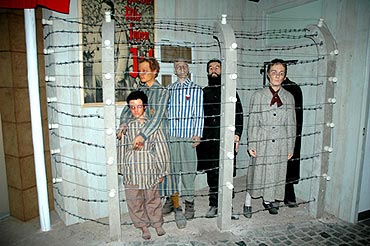Schrift: größer/kleiner
Inhaltsverzeichnis
Sie sind hier: WirRheinländer > english version > The Exhibition > Scenes > Deportation – around 1945
Deportation – around 1945

Concentration camps (KZ) as instruments of subjugation and elimination of opponents were not a German invention. They existed and exist in all totalitarian systems. Originally the Nazi ideologues used these „KZ"camps, in their contempt for humanity, to persecute opponents of the régime with terror. Later they designed a system for the methodical annihilation of entire peoples. The prisoners were at the mercy of brutal squads of guards, who tyrannized and humiliated them. Long, hard work, completely inadequate food, harassment, standing on parade for hours, medical experiments, epidemics and arbitrary executions led to their calculated deaths. The so-called Final Solution decided at the Wannsee conference was followed by the deportation of European Jews to extermination camps, such as Auschwitz, Treblinka and Mejdanek. It is estimated that of 7.5 million KZ camp prisoners, only about half a million survived.
An eye-witness describes life in such a camp:
"We were taken to a wooden hut. It was already pitch dark … a solitary light bulb dan-gled from the ceiling on a short wire. On both sides there were thirty double bunks. Each space was sixty centimetres wide. The bottom of the bunks consisted of loose slats in a frame, with one blanket per bed. We were given a bunk for the two of us. A shrill pea-whistle woke me. We were herded out of the hut, accompanied by the vile curses of guards. It was four o'clock in the morning, pitch dark and we had to line up for roll-call. … Maria, a Russian, was in charge, and she swore like a trooper. She also distributed the ladle full of „coffee", some undefinable, light grey muck. It was luke-warm and served both as breakfast and was used for washing, too. Everyone gave me a bit of theirs, so that I could wash my clothes in the latrine. It was disgusting."
(Sherman, Hilde, ehemals wohnhaft in Mönchengladbach, Zwischen Tag und Dunkel, Frankfurt a.M. 1993, S. 131f.)


